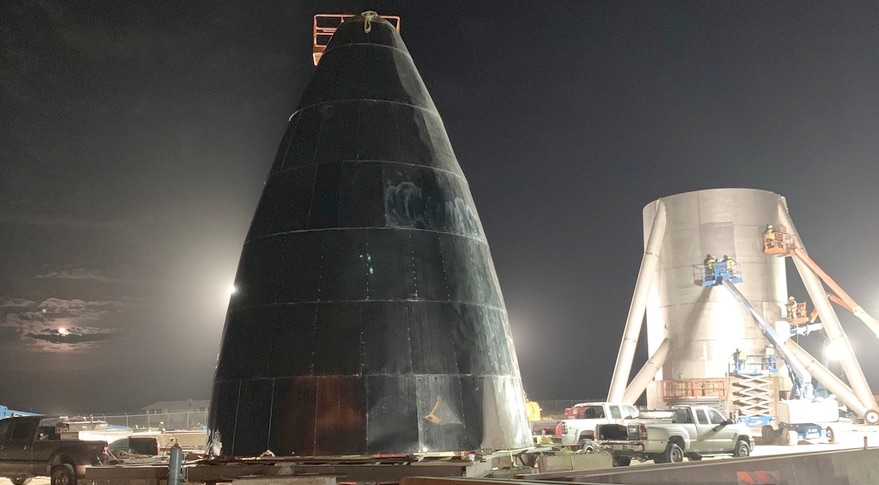Elon Musk Teases New Details About SpaceX's Redesigned Next-Generation Launch System

SANTA FE, N.M. — SpaceX Chief Executive Elon Musk says a redesigned test vehicle for the company's next-generation reusable launch system could be ready for initial flights early next year.
In a tweet early Dec. 24, Musk posted a photo of two parts of that initial test article, a conical section next to a cylindrical unit with landing legs. "Stainless Steel Starship," he wrote.
Stainless Steel Starship pic.twitter.com/rRoiEKKrYc
— Elon Musk (@elonmusk) December 24, 2018
Starship is the new name, announced by Musk last month, of the upper or "spaceship" stage of the next-generation launch system previously officially known as Big Falcon Rocket, or BFR. The lower, booster stage is now called "Super Heavy."
The company has been working on a Starship test article for low-altitude flight tests at the company's South Texas launch site under development. That test article, dubbed a "hopper," would have the same nine-meter diameter as the full-scale vehicle of the vehicle, but would not be as tall.
The company filed an application with the Federal Communications Commission Nov. 19, seeking an experimental license to support communications with the hopper during upcoming flights. SpaceX said it planned a combination of low-altitude flights, going no higher than 500 meters, and high-altitude ones, going as high as 5,000 meters, from the Texas site. The company didn't disclose a schedule for the flights in the application but said it expected to need the license for two years.
Musk and other company officials have said those hopper flights would begin in late 2019. However, Musk tweeted Dec. 22 that he expected those flights to begin as soon as early next year. "I will do a full technical presentation of Starship after the test vehicle we're building in Texas flies, so hopefully March/April," he wrote.
Get the Space.com Newsletter
Breaking space news, the latest updates on rocket launches, skywatching events and more!
The recent series of tweets from Musk also confirmed a change in materials that will be used to build the vehicle. Original plans, dating back to designs presented in 2016 and 2017, called for the use of carbon composite materials, which are lightweight but have high strength. Earlier this month, though, Musk said SpaceX had shifted to a "fairly heavy metal" for use in the vehicle.
That metal, he said, is stainless steel, in particular a family of alloys called 300 Series known to maintain its strength at high temperatures. Despite being heavier than carbon composites, Musk said that stainless steel offered "slightly better" strength-to-weight performance at cryogenic temperatures, needed for the vehicle’s liquid oxygen propellant tanks, and was “vastly better” at high temperatures. He acknowledged that steel was worse than carbon composite at room temperatures.
A stainless steel surface of the vehicle, he added, would require "much less" thermal protection but also would not be painted. "Skin will get too hot for paint," he tweeted. "Stainless mirror finish. Maximum reflectivity."
The test hopper will be powered by three of the company's Raptor methane/liquid oxygen engines under developments. Those engines, which the company has been working on for several years with some financial support from the U.S. Air Force, has undergone design changes as well. "Radically redesigned Raptor ready to fire next month," he tweeted, not elaborating on those changes.
He did note that SpaceX had developed a "superalloy" for Raptor, called SX500, designed to handle hot oxygen-rich gas at pressures of up to 12,000 pounds per square inch. "Almost any metal turns into a flare in those conditions," he wrote, adding that the company’s foundry for producing that alloy is "almost fully operational." That foundry "allows rapid iteration on Raptor."
This story was provided by SpaceNews, dedicated to covering all aspects of the space industry.
Join our Space Forums to keep talking space on the latest missions, night sky and more! And if you have a news tip, correction or comment, let us know at: community@space.com.

Jeff Foust is a Senior Staff Writer at SpaceNews, a space industry news magazine and website, where he writes about space policy, commercial spaceflight and other aerospace industry topics. Jeff has a Ph.D. in planetary sciences from the Massachusetts Institute of Technology and earned a bachelor's degree in geophysics and planetary science from the California Institute of Technology. You can see Jeff's latest projects by following him on Twitter.









